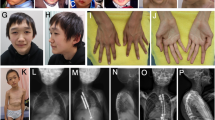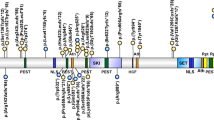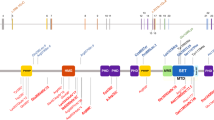Abstract
Genomic rearrangements are an increasingly recognized mechanism of human phenotypic variation and susceptibility to disease. Sotos syndrome is characterized by overgrowth, macrocephaly, developmental delay and advanced osseous maturation. Haploinsufficiency of NSD1, caused by inactivating point mutations or deletion copy number variants, is the only known cause of Sotos syndrome. A recurrent 2 Mb deletion has been described with variable frequency in different populations. In this study, we report two individuals of different ethnic and geographical backgrounds, with duplications reciprocal to the common Sotos syndrome deletion. Our findings provide evidence for the existence of a novel syndrome of short stature, microcephaly, delayed bone development, speech delay and mild or absent facial dysmorphism. The phenotype is remarkably opposite to that of Sotos syndrome, suggesting a role for NSD1 in the regulation of somatic growth in humans.
Similar content being viewed by others
Log in or create a free account to read this content
Gain free access to this article, as well as selected content from this journal and more on nature.com
or
References
Lupski JR : Structural variation in the human genome. N Engl J Med 2007; 356: 1169–1171.
Lupski JR, Stankiewicz P : Genomic disorders: molecular mechanisms for rearrangements and conveyed phenotypes. PLoS Genet 2005; 1: e49.
Lee J, Carvalho CM, Lupski JR : A DNA replication mechanism for generating nonrecurrent rearrangements associated with genomic disorders. Cell 2007; 131: 1235–1247.
Ensenauer RE, Adeyinka A, Flynn HC et al: Microduplication 22q11.2, an emerging syndrome: clinical, cytogenetic, and molecular analysis of thirteen patients. Am J Hum Genet 2003; 73: 1027–1040.
Somerville MJ, Mervis CB, Young EJ et al: Severe expressive-language delay related to duplication of the Williams-Beuren locus. N Engl J Med 2005; 353: 1694–1701.
Potocki L, Chen KS, Park SS et al: Molecular mechanism for duplication 17p11.2 – the homologous recombination reciprocal of the Smith-Magenis microdeletion. Nat Genet 2000; 24: 84–87.
Brunetti-Pierri N, Berg JS, Scaglia F et al: Recurrent reciprocal 1q21.1 deletions and duplications associated with microcephaly or macrocephaly and developmental and behavioral abnormalities. Nat Genet 2008; 40: 1466–1471.
Ballif BC, Theisen A, Coppinger J et al: Expanding the clinical phenotype of the 3q29 microdeletion syndrome and characterization of the reciprocal microduplication. Mol Cytogenet 2008; 1: 8.
Weiss LA, Shen Y, Korn J et al: Association between Microdeletion and Microduplication at 16p11.2 and Autism. N Engl J Med 2008; 358: 667–675.
Sharp AJ, Hansen S, Selzer RR et al: Discovery of previously unidentified genomic disorders from the duplication architecture of the human genome. Nat Genet 2006; 38: 1034–1042.
Koolen DA, Vissers LE, Pfundt R et al: A new chromosome 17q21.31 microdeletion syndrome associated with a common inversion polymorphism. Nat Genet 2006; 38: 999–1001.
Shaw-Smith C, Pittman AM, Willatt L et al: Microdeletion encompassing MAPT at chromosome 17q21.3 is associated with developmental delay and learning disability. Nat Genet 2006; 38: 974–976.
Sotos JF, Dodge PR, Muirhead D, Crawford JD, Talbot NB : Cerebral gigantism in childhood. A syndrome of excessively rapid growth and acromegalic features and a nonprogressive neurologic disorder. N Engl J Med 1964; 271: 109–116.
Kurotaki N, Imaizumi K, Harada N et al: Haploinsufficiency of NSD1 causes Sotos syndrome. Nat Genet 2002; 30: 365–366.
Rayasam GV, Wendling O, Angrand PO et al: NSD1 is essential for early post-implantation development and has a catalytically active SET domain. EMBO J 2003; 22: 3153–3163.
Huang N, vom Baur E, Garnier JM et al: Two distinct nuclear receptor interaction domains in NSD1, a novel SET protein that exhibits characteristics of both corepressors and coactivators. EMBO J 1998; 17: 3398–3412.
Stec I, Nagl SB, van Ommen GJ, den Dunnen JT : The PWWP domain: a potential protein-protein interaction domain in nuclear proteins influencing differentiation? FEBS Lett 2000; 473: 1–5.
Kurotaki N, Stankiewicz P, Wakui K, Niikawa N, Lupski JR : Sotos syndrome common deletion is mediated by directly oriented subunits within inverted Sos-REP low-copy repeats. Hum Mol Genet 2005; 14: 535–542.
Kurotaki N, Harada N, Shimokawa O et al: Fifty microdeletions among 112 cases of Sotos syndrome: low copy repeats possibly mediate the common deletion. Hum Mutat 2003; 22: 378–387.
Chen CP, Lin SP, Lin CC et al: Molecular cytogenetic analysis of de novo dup(5)(q35.2q35.3) and review of the literature of pure partial trisomy 5q. Am J Med Genet A 2006; 140: 1594–1600.
Kirchhoff M, Bisgaard AM, Bryndorf T, Gerdes T : MLPA analysis for a panel of syndromes with mental retardation reveals imbalances in 5.8% of patients with mental retardation and dysmorphic features, including duplications of the Sotos syndrome and Williams-Beuren syndrome regions. Eur J Med Genet 2007; 50: 33–42.
Menten B, Maas N, Thienpont B et al: Emerging patterns of cryptic chromosomal imbalance in patients with idiopathic mental retardation and multiple congenital anomalies: a new series of 140 patients and review of published reports. J Med Genet 2006; 43: 625–633.
Vermeesch J, Melotte C, Froyen G et al: Molecular karyotyping: array CGH quality criteria for constitutional genetic diagnosis. J Histochem Cytochem 2005; 53: 413–422.
Ou Z, Kang SH, Shaw CA et al: Bacterial artificial chromosome-emulation oligonucleotide arrays for targeted clinical array-comparative genomic hybridization analyses. Genet Med 2008; 10: 278–289.
Kent WJ, Sugnet CW, Furey TS et al: The human genome browser at UCSC. Genome Res 2002; 12: 996–1006.
Kent WJ : BLAT – the BLAST-like alignment tool. Genome Res 2002; 12: 656–664.
Saugier-Veber P, Bonnet C, Afenjar A et al: Heterogeneity of NSD1 alterations in 116 patients with Sotos syndrome. Hum Mutat 2007; 28: 1098–1107.
Acknowledgements
We thank our patients and their families for their cooperation. This work was made possible in part by grants from the IWT (SBO-60848) and GOA/2006/12, and from the SymBioSys Center of Excellence (Research Council, KU Leuven, EF/05/007) to JRV, and by grant R13-0005-04/2008 from the Polish Ministry of Science and Higher Education to PS.
Author information
Authors and Affiliations
Corresponding author
Rights and permissions
About this article
Cite this article
Franco, L., de Ravel, T., Graham, B. et al. A syndrome of short stature, microcephaly and speech delay is associated with duplications reciprocal to the common Sotos syndrome deletion. Eur J Hum Genet 18, 258–261 (2010). https://doi.org/10.1038/ejhg.2009.164
Received:
Revised:
Accepted:
Published:
Issue date:
DOI: https://doi.org/10.1038/ejhg.2009.164
Keywords
This article is cited by
-
Drosophila NSD deletion induces developmental anomalies similar to those seen in Sotos syndrome 1 patients
Genes & Genomics (2021)
-
5q35 duplication presents with psychiatric and undergrowth phenotypes mediated by NSD1 overexpression and mTOR signaling downregulation
Human Genetics (2021)
-
Identification of novel genomic imbalances in Saudi patients with congenital heart disease
Molecular Cytogenetics (2018)
-
Opposite effects on facial morphology due to gene dosage sensitivity
Human Genetics (2014)
-
Severe intellectual disability and autistic features associated with microduplication 2q23.1
European Journal of Human Genetics (2012)



